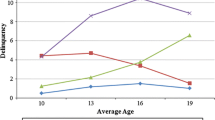Abstract
A substantial body of research suggests that age of onset is a viable discriminator of risk for chronic versus transient delinquency. Also, a mullivariate model of psychosocial variables (demographics, individual, school, and family functioning) appears likely to provide a comparatively accurate and useful discriminatory model for prediction. These two findings were applied to a normal sample of male adolescents (N=199, ages 15–18) to study the relationship of age of onset to delinquent behavior (as opposed to use of legal status to denote delinquency) and legal status. Additionally, the efficiency and improvement over chance accuracy of a multivariate model developed as part of a larger research project was tested. Results indicated that age of onset is an important and accurate discriminator of extent of subsequent delinquency. Subjects with an early age of onset reported more delinquent behavior, were more likely to be adjudicated, and showed different patterns of delinquency. A combination of demographic, individual, school, and family variables predicted age of onset.
Similar content being viewed by others
References
Andrew, J. M. (1981). Delinquency: Correlating variables.Journal of Clinical Child Psychology, 10, 136–140.
Empey, L. T. (1978).American delinquency: Its meaning and construction. Homewood, Illinois: Dorsey Press.
Erikson, E. H. (1968).Identity, youth, and crisis. New York: Norton Press.
Gold, M., & Petronio, R. J. (1980). Delinquent behavior in adolescence. In J. Adelson (Ed.),Handbook of adolescent psychology (pp. 495–535). New York: Wiley.
Hanson, C. L., Hennggeler, S. W., Haefle, W. F., & Rodick, J. D. (1984). Demographic, individual, and family relationship correlates of serious and repeated crime among adolescents and their siblings.Journal of Consulting and Clinical Psychology, 52, 528–538.
Hindelang, M. J., Hirschi, T., & Weis, J. G. (1981).Measuring delinquency. Beverly Hills: Sage.
Hindelang, M. J., & Weis, J. G. (1972). The bc-try cluster and factor analysis system: Personality and self-reported delinquency.Criminology, 10, 268–294.
Hollingshead, A. B. (1957).Two factor index of socioeconomic status. Unpublished manuscript, Yale University.
Johnson, J. H., & Overall, J. E. (1973). Factor analysis of the Psychological Screening Inventory.Journal of Consulting and Clinical Psychology, 41, 57–60.
Lanyon, R. I. (1970). Development and validation of a psychological screening inventory.Journal of Consulting and Clinical Psychology Monograph, 35, 1–37.
Loeber, R. (1982). The stability of antisocial and delinquent behavior: A review.Child Development, 53, 1431–1446.
Loeber, R., Dishion, T. (1983). Early predictors of male delinquency: A review.Psychological Bulletin, 94, 68–94.
Lorion, R. P. (1982). Evaluating preventive interventions: Guidelines for the serious social change agent. In R. D. Felner, L. Jason, J. Moritsugu, & S. Farber (Eds.),Preventive psychology: Theories, research, and practice in community interventions (pp. 251–268). New York: Pergamon Press.
McCord, J. (1979). A thirty year follow-up of treatment effects.American Psychologist, 33, 284–289.
Monahan, J. (1982). Childhood predictors of adult criminal behavior. In F. Dutile, C. Foust, & D. Webster (Eds.),Early childhood intervention and juvenile delinquency (pp. 11–21). Lexington, Massachusetts: D. C. Heath.
Moos, R. J., & Moos, B. S. (1981).Family Environment Scale manual. Palo Alto: Consulting Psychologists Press.
Olczak, P. V., Parcell, S. R., & Stott, M. W. (1983). Defining delinquency: Specificity of the research sample and the right to treatment.Journal of Clinical Psychology, 39, 1007–1012.
Olweus, D. (1979). Stability of aggressive reaction patterns in males: A review.Psychological Bulletin, 86, 852–875.
Osborn, S. G., & West, D. J. (1978). The effectiveness of various predictors of criminal careers.Journal of Adolescence, 1, 101–117.
Patterson, G. R. (1982).Coercive family processes, Eugene, Oregon: Castalia.
Pentz, M. A. (1983).Transition proneness: The effect of grade, school, and family changes on adolescent drug use. Unpublished grant proposal, National Institute of Drug Abuse, Grant 1R01 DA02630-01A1.
Pentz, M. A., & Tolan, P. H. (1984).Social skills training with adolescents: A critical review of time trends, dimensions, and outcome, 1972–1982. Unpublished manuscript.
Quay, H. C. (1975). Classification in the treatment of delinquency and antisocial behavior, In N. Hobbs (Ed.),Issues in the classification of children (Vol. 2, pp. 377–382). San Francisco: Jossey-Bass.
Simcha-Fagan, O. (1979). The prediction of delinquent behavior over time: Sex specific patterns related to official and survey-reported delinquent behavior. In R. G. Simmons (Ed.),Research in community mental health (pp. 163–177). Greenwich, Connecticut: JAI Press.
Streib, V. L. (1980). From Gault to Fare to Smith: The decline in Supreme Court reliance on delinquency theory.Pepperdine Law Review, 7, 801–826.
Tennessee Code Annotated. (1982). Charlottesville, Virginia: Michie Co.
Tolan, P. H. (1983).Multivariate identification of delinquent behavior in males. Unpublished doctoral dissertation, University of Tennessee.
Tolan, P. H. (1984, May).Some considerations for research within the juvenile justice system. Paper presented at the annual meeting of the Midwestern Psychological Association, Chicago.
Tolan, P. H. (1985, August).Normal adolescent development and deliquency proneness prediction. Paper presented at the annual meeting of American Psychological Association, Los Angeles.
Tolan, P. H., Cromwell, R. E., & Brasswell, M. (1986). Family therapy with delinquents: A critical review of the literature.Family Process, 25, 619–650.
Tolan, P. H., & Lorion, R. P. (in press). Multivariate models of delinquent behavior in males.American Journal of Community Psychology.
West, D. J., & Farrington, D. P. (1977).The delinquent way of life. London: Heinemann.
Wolfgang, M. E., Figlio, R. M., & Stellin, T. (1972).Delinquency in a birth cohort. Chicago: University of Chicago Press.
Author information
Authors and Affiliations
Additional information
This work was conducted while the author was a Clinical Research Training Fellow in Adolescence (funded by T32 MH 14668) at the Institute for Psychosomatic and Psychiatric Research and Training, Michael Reese Hospital and Medical Center, in a program also sponsored by the Departments of Behavioral Science and Psychiatry, University of Chicago, and the Adolescent Program of the Illinois State Psychiatric Institute. The author is indebted to Ronald Rosenthal, Daniel Offer, and two anonymous reviewers for their advice and comments on an earlier draft of this article.
Rights and permissions
About this article
Cite this article
Tolan, P.H. Implications of age of onset for delinquency risk. J Abnorm Child Psychol 15, 47–65 (1987). https://doi.org/10.1007/BF00916465
Issue Date:
DOI: https://doi.org/10.1007/BF00916465




